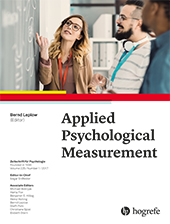Intercultural Competence Development Among University Students From a Self-Regulated Learning Perspective
Theoretical Model and Measurement
Abstract
Abstract. Intercultural competence is defined as a lifelong learning task that can be developed in any intergroup situation. A self-regulated learning model is applied to better understand the intercultural learning process that is initiated during the forethought phase, monitored during the performance phase, and evaluated during the self-reflection phase. In each phase, particular psychological constructs are important to initiate, monitor, and evaluate the learning process. The empirical goals of the present study were (1) to develop a self-report questionnaire capturing the three learning phases, (2) to test the theoretical structure of the proposed intercultural learning process, and (3) to examine two theoretically meaningful learning cycles. Data were collected from 188 women and 48 men aged 18–47 years (M = 26.41, SD = 6.19). Structural equation models (SEMs) demonstrated that intercultural learning goals, intercultural self-efficacy, and intercultural intrinsic interest form the latent factor forethought phase. In line with composite models of intercultural competence, the intercultural learning goals had a three-factor structure (knowledge domain, attitude domain, communication domain). Self-monitoring, self-recording, and self-experimentation form the latent factor performance phase. Mediation analyses provided initial evidence of the existence of two distinct learning cycles: (1) The forethought phase precedes the performance phase which precedes both self-evaluation and success attribution on intercultural competence (constructs of the self-reflection phase). (2) The performance phase precedes optimizing future learning (construct of the self-reflection phase) which precedes the forethought phase indicating the emergence of a future learning action. The theoretical and practical value of the newly developed self-assessment of intercultural competence is discussed.
References
(1986). The moderator-mediator variable distinction in social psychological: Conceptual, strategic, and statistical considerations. Journal of Personality and Social Psychology, 51, 1173–1182. doi: 10.1037/0022-3514.51.6.1173
(2013).
Intercultural competence: A distinctive hallmark of interculturalism? . In M. BarrettEd., Interculturalism and multiculturalism: Similarities and differences (pp. 147–168). Strasbourg, France: Council of Europe.(1986a).
Towards ethnorelativism: A developmental model of intercultural sensitivity . In R. M. PaigeEd., Cross-cultural orientation: New conceptualizations and applications (pp. 27–70). New York, NY: University Press of America.(1986b). A developmental approach to training for intercultural sensitivity. International Journal of Intercultural Relations, 10, 179–196. doi: 10.1016/0147-1767(86)90005-2
(1990). Comparative fit indexes in structural models. Psychological Bulletin, 107, 238–246.
(2006). Interkultureller Trainingsbedarf aus der Perspektive der Problemerfahrungen entsandter Führungskräfte
[Need for intercultural training from the perspective of manager’s abroad with problem experiences] . Interkulturelles Lernen, interkulturelles Training (pp. 57–75). Munich, Germany: Hampp.(2015).
Intercultural competence: Mapping the future research agenda . In K. GötzEd., International Journal of Intercultural Relations (48, pp. 3–5). doi: 10.1016/j.ijintrel.2015.03.002(2006). Identification and assessment of intercultural competence as a student outcome of internationalization. Journal of Studies in International Education, 10, 241–266. doi: 10.1177/1028315306287002
(2010). Interkulturelle Kompetenzen–Erfolgreich kommunizieren zwischen den Kulturen
[Intercultural competencies – successful communication between cultures] . Stuttgart, Germany: Klett Lerntraining.(2009).
Assessing intercultural competence: Issues and tools . In D. K. DeardorffEd., The sage handbook of intercultural competence (pp. 456–476). Thousand Oaks, CA: Sage.(2011). Additional cross-cultural validity testing of the Intercultural Development Inventory. International Journal of Intercultural Relations, 35, 474–487. doi: 10.1016/j.ijintrel.2011.02.014
(2015). The developmental paradigm for intercultural competence research. International Journal of Intercultural Relations, 48, 12–13. doi: 10.1016/j.ijintrel.2015.03.004
(2012). Developing and evaluating intercultural competence: Ethnographies of intercultural encounters. International Journal of Intercultural Relations, 36, 707–718. doi: 10.1016/j.ijintrel.2012.04.010
(1999). Schulbezogene Selbstwirksamkeitserwartung
[Self-efficacy expectations at school] . Skalen zur Erfassung von Lehrer-und Schülermerkmalen (pp. 15–16). Berlin, Germany: FU.(2015).
Intercultural communication competence: Theory, measurement, and application . In R. SchwarzerM. JerusalemEds., International Journal of Intercultural Relations (pp. 20–21). 48. doi: 10.1016/j.ijintrel.2015.03.006(1997). Mean and covariance structures (MACS) analyses of cross-cultural data: Practical and theoretical issues. Multivariate Behavioral Research, 32, 53–76. doi: 10.1207/s15327906mbr3201_3
(2013). Assessing cross-cultural competence: A review of available tests. Journal of Cross-Cultural Psychology, 44, 849–873. doi: 10.1177/0022022113492891
(2003). A motivational science perspective on the role of student motivation in learning and teaching contexts. Journal of Educational Psychology, 95, 667–686.
(1993). Der “Fragebogen zum Studieninteresse” (FSI)
[Study interest questionnaire] . Diagnostica, 39, 335–351.(2003). Fragebogen Selbstregulation,
[Questionnaire self-regulation] . Unpublished questionnaire, TU Darmstadt, Darmstadt.(2009).
Conceptualizing intercultural competence . In D. K. DeardorffEd., The sage handbook of intercultural competence (pp. 1–52). Thousand Oaks, CA: Sage.(2011).
Interpersonal skills . In M. L. KnappJ. A. DalyEds., Handbook of interpersonal communication (4th ed., pp. 481–524). Newbury Park, CA: Sage.(1990). Structural model evaluation and modification: An interval estimation approach. Multivariate Behavioral Research, 25, 173–180. doi: 10.1207/s15327906mbr2502_4
(1998). Facework competence in intercultural conflict: An updated face-negotiation theory. International Journal of Intercultural Relations, 22, 187–225. doi: 10.1016/S0147-1767(98)00004-2
(2009).
Methodological issues in researching intercultural competence . In D. K. DeardorffEd., The sage handbook of intercultural competence (pp. 404–418). Thousand Oaks, CA: Sage.(2005).
Motivation from an attribution perspective and the social psychology of perceived competence . In A. J. ElliotC. S. DweckEds., Handbook of competence and motivation (pp. 73–84). New York, NY: Guilford Press.(1998). Study strategies for lifelong learning. Washington, DC: American Psychological Association.
(2000). Expectancy-value theory of achievement motivation. Contemporary Educational Psychology, 25, 68–81. doi: 10.1006/ceps.1999.1015
(2000). Motiviertes selbstgesteuertes Lernen im Studium
[Motivated self-regulated learning in university students] . Landau, Germany: Verlag Empirische Pädagogik.(2000).
Attaining self-regulation. A social cognitive perspective . In M. BoekaertsP. R. PintrichM. ZeidnerEds., Handbook of self-regulation (pp. 13–39). London, UK: Academic Press.



